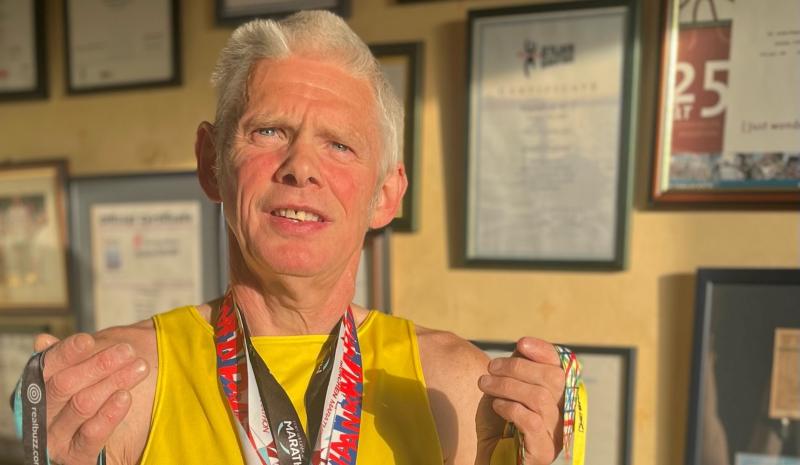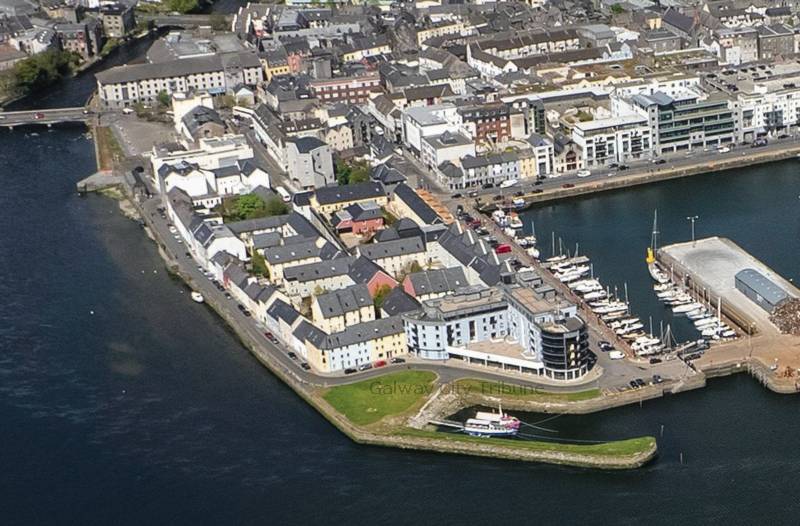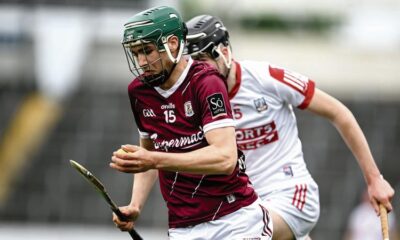Featured
Uniquely Irish dogs are central to our history

Lifestyle – Judy Murphy meets a Galwayman putting Ireland’s native dog breeds in the spotlight
When Michael Collins wasn’t leading the military campaign against England during Ireland’s War of Independence (1919 -1921), he had a penchant for exhibiting Kerry Blue Terriers.
Cork-born Collins was a fan of this uniquely Irish breed of dog, and owned several. The best known was Convict 224. Collins was such a fan of the Kerry Blue that he wanted the breed to become the National Dog of Ireland.
This fascinating nugget is contained in the gorgeous picture-book, Native Irish Dogs. Just published by Currach Press it features a selection of heart-warming photos by Colin White, accompanied by text from Galway-man Shane McCoy giving information on the nine native Irish breeds as defined by the Irish Kennel Club.
Shane’s day job is in Marketing and Publicity with Dublin based Columba Press, which specialises in books of a spiritual and theological nature.
Some years ago, Columba set up the Currach imprint to publish secular titles, specialising in material with an Irish focus and Shane’s brief extends across both Columba and Currach.
The company regularly draws up ideas for new books and it was at one such meeting that Shane – the proud owner of a pug – suggested a book on Irish dogs for Currach Press. They commissioned Colin White to travel the length and breadth of Ireland, photographing these nine breeds that that evolved specifically to cater for Irish needs, both those of the peasants and the gentry. From the stately Irish Wolfhound to the peculiar looking Glen of Imaal Terrier, all of these animals had a job to do – they were bred long before the era of “companion dogs”, explains Shane, who had been already fairly well-informed about the nine native Irish breeds because he is a regular at dog shows with his own pug, Louie.
He also knew that the President of the Irish Kennel Club, Sean Delmar would support Currach in producing a book about these breeds, several of which are vulnerable.
So, Shane was a natural choice when it came to deciding who would write text to accompany Colin White’s stunning photos of these dogs.
In addition to being a dog lover, he was well placed to put these animals in a historical context, as the Milltown man has a degree in Literature and Celtic Civilisation from NUIG. Shane went to Columba five years ago as an intern after doing a Masters in Literature and Publishing, also at NUIG and his subsequently joined the staff.
He set about his doggy research with enthusiasm and there are nine chapters, with easily-digested information on each breed’s background, its function and its temperament.
The best-known of the native Irish breeds is the Irish Wolfhound which supposedly came with the Celts, according to Shane, who adds nobody really knows that for sure. But what is certain is that it’s an ancient breed, and one mentioned in Irish folklore, including the story of Cúchulainn. Initially a battle-dog, it may initially have been used by soldiers in hand-to-hand combat. Later on, wolfhounds were used to hunt wolves.
“They would have been strong enough to catch and kill a wolf,” says Shane, explaining that they were status symbols.
Only kings and nobility were allowed to own them and “the more you had of them, the better off you were”.
Ireland’s history is reflected in these nine dogs, as this book demonstrates.
Shane explains that under a draconian Penal Law introduced in 1704, Irish Catholics weren’t allowed to own Irish Wolfhounds, or any dog worth more than five pounds.
For more, read this week’s Connacht Tribune.
Connacht Tribune
West has lower cancer survival rates than rest

Significant state investment is required to address ‘shocking’ inequalities that leave cancer patients in the West at greater risk of succumbing to the disease.
A meeting of Regional Health Forum West heard that survival rates for breast, lung and colorectal cancers than the national average, and with the most deprived quintile of the population, the West’s residents faced poorer outcomes from a cancer diagnosis.
For breast cancer patients, the five-year survival rate was 80% in the West versus 85% nationally; for lung cancer patients it was 16.7% in the west against a 19.5% national survival rate; and in the West’s colorectal cancer patients, there was a 62.6% survival rate where the national average was 63.1%.
These startling statistics were provided in answer to a question from Ballinasloe-based Cllr Evelyn Parsons (Ind) who said it was yet another reminder that cancer treatment infrastructure in the West was in dire need of improvement.
“The situation is pretty stark. In the Western Regional Health Forum area, we have the highest incidence of deprivation and the highest health inequalities because of that – we have the highest incidences of cancer nationally because of that,” said Cllr Parsons, who is also a general practitioner.
In details provided by CEO of Saolta Health Care Group, which operates Galway’s hospitals, it was stated that a number of factors were impacting on patient outcomes.
Get the full story in this week’s Connacht Tribune, on sale in shops now, or you can download the digital edition from www.connachttribune.ie. You can also download our Connacht Tribune App from Apple’s App Store or get the Android Version from Google Play.
Connacht Tribune
Marathon Man plans to call a halt – but not before he hits 160 races

On the eve of completing his 150th marathon, an odyssey that has taken him across 53 countries, Loughrea’s Marathon Man has announced that he is planning to hang up his running shoes.
But not before Jarlath Fitzgerald completes another ten races, making it 160 marathons on the occasion of his 60th birthday.
“I want to draw the line in 2026. I turn 57 in October and when I reach 60 it’s the finishing line. The longer races are taking it out of me. I did 20 miles there two weeks ago and didn’t feel good. It’s getting harder,” he reveals.
“I’ve arthritis in both hips and there’s wear and tear in the knees.”
We speak as he is about to head out for a run before his shift in Supervalu Loughrea. Despite his physical complaints, he still clocks up 30 miles every second week and generally runs four days a week.
Jarlath receives injections to his left hip to keep the pain at bay while running on the road.
To give his joints a break, during the winter he runs cross country and often does a five-mile trek around Kylebrack Wood.
He is planning on running his 150th marathon in Cork on June 4, where a group of 20 made up of work colleagues, friends and running mates from Loughrea Athletics Club will join him.
Some are doing the 10k, others are doing the half marathon, but all will be there on the finishing line to cheer him on in the phenomenal achievement.
Get the full story in this week’s Connacht Tribune, on sale in shops now, or you can download the digital edition from www.connachttribune.ie. You can also download our Connacht Tribune App from Apple’s App Store or get the Android Version from Google Play.
CITY TRIBUNE
Galway ‘masterplan’ needed to tackle housing and transport crises

From the Galway City Tribune – An impassioned plea for a ‘masterplan’ that would guide Galway City into the future has been made in the Dáil. Galway West TD Catherine Connolly stated this week that there needed to be an all-inclusive approach with “vision and leadership” in order to build a sustainable city.
Deputy Connolly spoke at length at the crisis surrounding traffic and housing in Galway city and said that not all of the blame could be laid at the door of the local authority.
She said that her preference would be the provision of light rail as the main form of public transport, but that this would have to be driven by the government.
“I sat on the local council for 17 years and despaired at all of the solutions going down one road, metaphorically and literally. In 2005 we put Park & Ride into the development plan, but that has not been rolled out. A 2016 transport strategy was outdated at the time and still has not been updated.
“Due to the housing crisis in the city, a task force was set up in 2019. Not a single report or analysis has been published on the cause of the crisis,” added Deputy Connolly.
She then referred to a report from the Land Development Agency (LDA) that identified lands suitable for the provision of housing. But she said that two-thirds of these had significant problems and a large portion was in Merlin Park University Hospital which, she said, would never have housing built on it.
In response, Minister Simon Harris spoke of the continuing job investment in the city and also in higher education, which is his portfolio.
But turning his attention to traffic congestion, he accepted that there were “real issues” when it came to transport, mobility and accessibility around Galway.
“We share the view that we need a Park & Ride facility and I understand there are also Bus Connects plans.
“I also suggest that the City Council reflect on her comments. I am proud to be in a Government that is providing unparalleled levels of investment to local authorities and unparalleled opportunities for local authorities to draw down,” he said.
Then Minister Harris referred to the controversial Galway City Outer Ring Road which he said was “struck down by An Bord Pleanála”, despite a lot of energy having been put into that project.
However, Deputy Connolly picked up on this and pointed out that An Bord Pleanála did not say ‘No’ to the ring road.
“The High Court said ‘No’ to the ring road because An Bord Pleanála acknowledged it failed utterly to consider climate change and our climate change obligations.
“That tells us something about An Bord Pleanála and the management that submitted such a plan.”
In the end, Minister Harris agreed that there needed to be a masterplan for Galway City.
“I suggest it is for the local authority to come up with a vision and then work with the Government to try to fund and implement that.”












